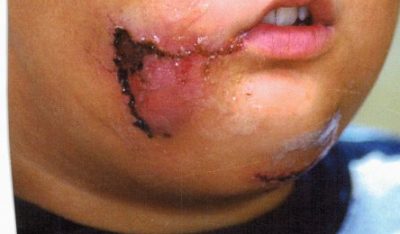
Dog bites to the face of a person often result in a lawsuit filed against the dog owner. Lawsuits are warranted in part because serious facial dog bites are often traumatizing and devastating to the victim, particularly if the victim is a child.
Millions of dollars are spent annually in the United States for surgical repair of a dog bite to the face. Treatment often consists of minimizing disfigurement through reconstructive surgery. But perhaps more difficult to treat is a post-traumatic stress disorder that often follows a serious dog bite to the face.
I suspect that facial dog bites often happen when a person suddenly and unexpectedly places his/her face too close to the face of a dog. Circumstances differ as to when and why this happens, however. Generally, an aggressive response from a dog has the potential of being elicited when a person (often a child) bends over a dog to initiate social interaction or when a dog’s personal space is invaded suddenly by an unfamiliar person. Some dogs will not be accepting of a sudden intrusion near the face and will bite the person for defensive reasons.
A comprehensive study on facial dog bites
With the above in mind, I found a 2015 study reported by animal behavior scientists in Czechoslovakia of considerable interest. This study provides the most in-depth understanding to date of factors associated with facial dog bites inflicted to people. (Human behavior preceding dog bites to the face. P. Rezac, et. al. The Veterinary Journal, 2015, 206, 284-238). [1]Richard Polsky is a dog bite expert in California. Dr.Polsky has been retained frequently by attorneys as an expert to opine about facial dog bites and the circumstances that contribute and give … Continue reading
Data collection in this study was somewhat unique because it was limited to facial injuries only. Excluded from the analysis, as is typical in most other dog bite research, were injuries inflicted other parts of the body (extremities, torso, etc.). Victims were recruited into the study through their response to flyers posted at a veterinary hospital and at dog shows in the Czech Republic between January 2012 – June 2014. Questionnaires were given to 132 participants. Inquiry was made into what the victim was doing immediately prior to being bitten in the face, the gender and age of the victim, how well the victim knew the dog, the age, gender and size of the dog, where the incident took place, and if a parent was present at the time of the incident.
The most noteworthy findings showed that for 76% of the occurrences the victim was bending over the dog when the incident happened. Moreover, for 19% of the occurrences, the victim placed his/her face too close to the dog, and in 5% of the instances, mutual eye contact was made between the victim and the dog.
Other findings included: (a) Most instances occurred in the territory of an off-leash, adult male, German Shepherd or Daschund, and (b) Children under the age of 18 were involved in 70% of the instances (84% of this total involved children less than 12 years). This latter finding is consistent with nearly all of the evidence to date about the epidemiology of dog bites: namely, children are disproportionately involved. And what’s important to note is that in this study in most instances the parent was not present at the time of the incident. The latter finding is significant because it touches upon a legal issue that occasionally arises in dog bite lawsuits; namely, negligent supervision. In addition, this finding also suggests that the presence of a parent may not deter a dog bite from biting a child.
Moreover, nearly all victims (94%) reported that the dog gave no warning (snarling, growling) before the attack. This finding demonstrates how quickly incidences like this can happen. That is, a dog will attack without warning. It also speaks to the comprehension young children have about warning signs displayed by potentially aggressive dogs. That is, young children may report that snarling or vocalization did not occur because of a failure to recognize due to a lack of understanding of what these social signals mean.
A high profile facial dog bite
The above has relevance in light of the January 2017 dog bite incident involving President Obama’s four-year-old, male Portuguese water dog, Sunny. President Obama’s dog attacked an 18-year old girl on the face during her visit to the White House. She was a family friend from Chicago. The incident happened when the girl bent down to pet and kiss Sunny. She sustained a gash under her right eye which required stitches. When asked about the incident, Pres. Obama’s press secretary responded: “Both Bo and Sunny have been ambassadors to the American people. Thousands of people have had the opportunity to interact, play with those dogs, and pet with those dogs.” Assuming this is true, then given Sunny’s behavioral history, I wonder if this girl unknowingly provoked Sunny in some fashion?
Footnotes
| ↑1 | Richard Polsky is a dog bite expert in California. Dr.Polsky has been retained frequently by attorneys as an expert to opine about facial dog bites and the circumstances that contribute and give rise to this kind of injury. |
|---|
